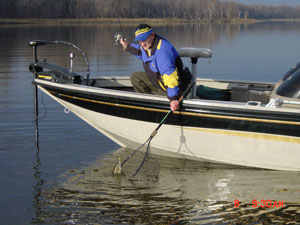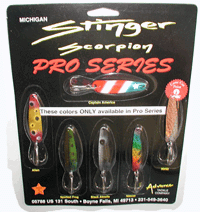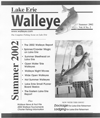Where thereís a will thereís a way, especially if your will is to get in
on some early season walleye action. The "way" will depend on where you are,
or how far youíre willing to travel. There are some exceptional "ways" available to todayís anglers throughout the country,
and includes some extremely productive river stretches.
some exceptional "ways" available to todayís anglers throughout the country,
and includes some extremely productive river stretches.
In Minnesota you canít have a conversation on early season walleye
angling without including the Mississippi River as well as the Rainy River
on the Canadian border. The reason for the inclusion is the fact that those
are basically the only options, as the rest of the Stateís waters remain
closed. In Wisconsin itís the Fox and Wolf rivers. In Illinois itís the
Maumee, Sandusky and Illinois rivers. The truth is there is probably a fair
amount of decent action happening within a reasonable drive for most early
season anglers.
Heading for a river in search of olímarble eyes can be a feast or famine
proposition early in the season, and unfortunately heavy on the famine for
most first timers. However, by reading up on a little pre-trip info you
might be able to have your cake and eat it too.
Famine comes into play whenever anglers fail to adjust to an ever
changing river environment, and change is the only constant. Take the ups
and downs of early seasonwater levels, add in clarity that can run from
clear to pure mud, and then throw in the annual spawning cycle for good
measure and you have a scenario that is impossible to setin stone. The
good new is that even with all of those variables you can still be
successfulif you stay fluid and go with the flow.
According to professional walleye angler and river aficionado Jimmy Bell
of Ham Lake, Minnesota; "The most important factor effecting walleye
location during the earliest part of the season is the presence of baitfish.
If you can find the bait you can find the walleyes. The more you know about
the forage base the better off youíll be.
On pools 2 and 3 of the Mississippi River where I spend a good deal of
time the main forage base is shad, which can be readily found with a good
graph. Iíve been using a Garmin 2010C color graph and have found that it
will clearly mark schools of suspendedbait as well as anything holding tight
to the bottom. Look for schools of bait to hold infront of and behind wind
dams, in deeper holes, as well as along any type of current break."
Water levels are another important consideration and can vary greatly
from week to week and even day to day, depending on the prevailing
conditions. Light run-off and low water levels tend to spread walleyes
throughout a system while heavy run-off and higher levels will bunch them
up.
"The higher the levels the more concentrated theyíll be. The process can
be slow or quick, depending on just how fast water levels rise. For example:
Walleyes that were previously holding in deeper water off the tip of a wing
dam may now be packed in tight to shore on the downstream side of the dam,
if thereís enough current.
Secondary channels are another hot spot and may be several miles or more
downstream from any impeding dam. The key to finding walleyes in secondary
channels is current, as they simply wonít hold any appreciable numbers
without it.
When water levels peak and are at their highest levels you need to start
looking for seams close to shore, instead of the usual major current breaks.
A seam is a small current break that can be hard to detect, but may hold
plenty of high water walleyes. They become easier to read when there are
buds falling, like those that drop from maple trees. The buds will stack up
along the edge of a seam and it becomes much easier to detect."
Water clarity is the next item on the list that has to be dealt with.
Just how dark or clear things are will require small but important
variations in your presentation. "For the most part when Iím working clear
water Iíll probably be pitching light jigs in the 1/16 to 1/8oz range tipped
with minnows to the shore, and working them back through the current break.
Iíll also use high vis line to help me keep track of my bait. When a walleye
picks up the bait many times the only indication youíll get is a slight
twitch in the line and the high vis line lets me actually see the bite.
Dark or muddy water calls for something else and is when Iíll start using
big plastic baits without the benefit of any live bait. Bigger plastic baits
provide a larger profile and create more commotion than a smaller jig and
minnow, and are an easier target for olí marble eyes to hone in on. A
plastic bait like a four or five inch lizard can be absolutely deadly at
times, and is an option thatís often overlooked."
Bell also uses the brightest colored baits he can find and will actually
take the time to use a special dip to get the desired effect if he feels the
need. "If itís dark enough Iíll actually jig straight up and down in
two or three feet of water and slowly work down river along the edge of a
seam. Fish that shallow can be easily spooked and you have to take some
extra precaution to prevent that from happening, like running your trolling
motor at a constant speed.
Starting and stopping an electric trolling motor can spook fish and may
ruin your chances of finding active shallow. Instead, Iíll set the desired
speed on my Minn Kota and let it run on constant until I am completely
through an area."
Besides current and clarity thereís that doggone spawning cycle which can
definitely change things and has to be addressed. According to Bell; "When
you get close to the spawn look for walleyes to line up near flooded weeds
like cane. Walleyes will actually use the weeds to drop their eggs in, and
is where most of the river spawning takes place."
It certainly doesnít fit the bill of "classic walleye behavior" but
tracking studies have shown the phenomenon to be true. See you on the river.





 some exceptional "ways" available to todayís anglers throughout the country,
and includes some extremely productive river stretches.
some exceptional "ways" available to todayís anglers throughout the country,
and includes some extremely productive river stretches.